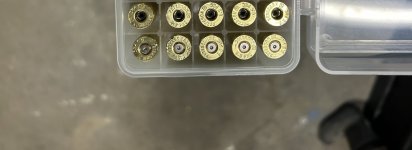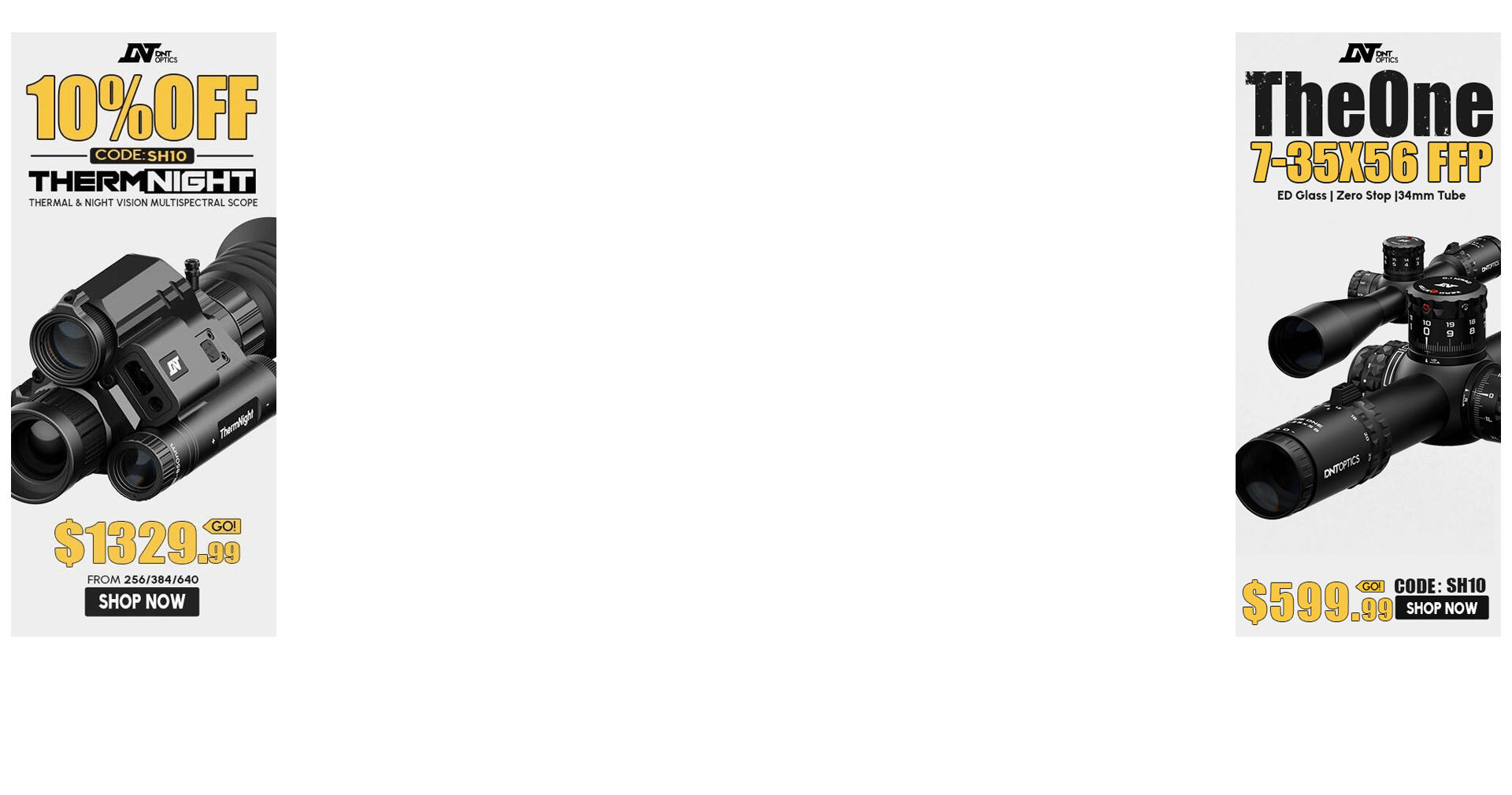Looking for some general information on reloading for a short (18") 6.5 prc with 135 a Tips (156 berger load data also would be helpful). Mostly looking for powder recommendations as most data is for 24" Barrels and longer. I have quite a bit of varget, but see H1000, retumbo and N565 recommended a lot. Just not sure if these are still good routes to go for a short barrel. If anyone has any recommendations and can post starting loads and what speeds they are seeing from these shorter barrels it would be appreciated
Join the Hide community
Get access to live stream, lessons, the post exchange, and chat with other snipers.
Register
Download Gravity Ballistics
Get help to accurately calculate and scope your sniper rifle using real shooting data.

Install the app
How to install the app on iOS
Follow along with the video below to see how to install our site as a web app on your home screen.
Note: This feature may not be available in some browsers.
You are using an out of date browser. It may not display this or other websites correctly.
You should upgrade or use an alternative browser.
You should upgrade or use an alternative browser.
18" 6.5 PRC and 135 A tips
- Thread starter NateAdams13
- Start date
Though shorter barrels don't get the benefit of slower burning powders like H-1000, like ~7% of it goes unburnt, it'll fill the cases better than faster burning powders. I'd suggest something more like N555, H4831 SC or IMR 7828 SSC for the short barrel. A lot of good things said of N555.Looking for some general information on reloading for a short (18") 6.5 prc with 135 a Tips (156 berger load data also would be helpful). Mostly looking for powder recommendations as most data is for 24" Barrels and longer. I have quite a bit of varget, but see H1000, retumbo and N565 recommended a lot. Just not sure if these are still good routes to go for a short barrel. If anyone has any recommendations and can post starting loads and what speeds they are seeing from these shorter barrels it would be appreciated
Seems 4831SC is a good option here, and its in stock. Might give it a go with that.
I am also looking into the 129 nosler ABLR for next deer season. Should be able to get near 2900 fps hopefully from the 18"
Yes, with either 4831 SC, RL-23 or N560. N560 would be you best bet for that.I am also looking into the 129 nosler ABLR for next deer season. Should be able to get near 2900 fps hopefully from the 18"
Shorter barrels will get the benefit of slower powders just like the longer barrels but with more unburnt powder and muzzle flash. Shorter barrels do benefit from lighter bullets and faster powder in terms of burnout and less muzzle flash.
Things to keep in mind:
You can't make up the velocity benefit of a longer barrel!
Slower powders take longer barrel time to burn out.
Unburnt powder may/can affect accuracy/precision.
Things to keep in mind:
You can't make up the velocity benefit of a longer barrel!
Slower powders take longer barrel time to burn out.
Unburnt powder may/can affect accuracy/precision.
The same powder that provide peak velocity in a longer barrel will also provide peak velocity in a shorter barrel. If reducing muzzle flash/blast is important to you a faster powder can be used but it will reduce velocity.
As others have mentioned for rifle length barrels, the powders that give the best velocities in longer barrels usually give the best velocities in shorter barrels too. In your case, you might try Ramshot Grand, it's been giving me the best velocities with good accuracy in my 19" 7 PRC, and from the data looks like it should do well in the 6.5 as well. Burn speed is right next to H1000 and RL-26, it's temp stable, available unlike RL-26, cheaper than H1000 and faster than either in my PRC, worth a try.
Its working very well for me on 18" and 20" 6.5 PRC's.Seems 4831SC is a good option here, and its in stock. Might give it a go with that.
What velocities are you seeing?Its working very well for me on 18" and 20" 6.5 PRC's.
18” is running 130’s at 2900 so far (still working upward).What velocities are you seeing?
20” is running 2940 with 140’s.
Each are shooting sierra game changers.
Can I ask what charge you’re using in the 18 to hit that 2900? So far I’ve worked to 56 grains, and barely broken 2700 with the 13518” is running 130’s at 2900 so far (still working upward).
20” is running 2940 with 140’s.
Each are shooting sierra game changers.
I went out today to start load development. For reference, this is a tikka veil that was cut and threaded at 18" by class 3 machine. It has a total of about 60 rounds through it (I may be wasting my time starting any of this before giving the barrel a chance to speed up, which i certainly hope it does). Temperature today was about 50 degrees. Hornady lists 51.1-56.6 for H4831SC. I loaded (5 shots of each) 53-56 in .5 grain increments. I do not show any pressure signs on the brass and will continue to go up. Velocities were much lower than I had hoped with the 135s so far.
This was all done with new peterson brass.
53 grains was 2564 average, 53.5 was 2581.5, 54 was 2601.3, 54.5 was 2618.9, 55 was 2662.6, 55.5 was 2685.6 and 56 was 2704.2. I found it a little strange that i only averaged about 18 fps gain for 0.5 grain increment bumps (aside from the 43.7 jump from 54.5 to 55). Everything shot relatively well, most around .5-.75 and SD/ES was relatively good. These are all seated 25 thousands off the lands.
As stated I will continue to work up, but based on the velocities shown so far (unless the barrel speeds significantly in the next 100-150 rounds) I may pressure out before breaking 2800-2850.
Factory Hornady outfitter 130 grain was 2751.7 and grouped okay, quite well if I don't account for the flyer on the bottom. The shot above the group was my initial sighter.
I do have some H1000 that may be worth trying as well.
Also, ignore the "federal 205" on the primer, these were federal 210s, i just miswrote on every target.
This was all done with new peterson brass.
53 grains was 2564 average, 53.5 was 2581.5, 54 was 2601.3, 54.5 was 2618.9, 55 was 2662.6, 55.5 was 2685.6 and 56 was 2704.2. I found it a little strange that i only averaged about 18 fps gain for 0.5 grain increment bumps (aside from the 43.7 jump from 54.5 to 55). Everything shot relatively well, most around .5-.75 and SD/ES was relatively good. These are all seated 25 thousands off the lands.
As stated I will continue to work up, but based on the velocities shown so far (unless the barrel speeds significantly in the next 100-150 rounds) I may pressure out before breaking 2800-2850.
Factory Hornady outfitter 130 grain was 2751.7 and grouped okay, quite well if I don't account for the flyer on the bottom. The shot above the group was my initial sighter.
I do have some H1000 that may be worth trying as well.
Also, ignore the "federal 205" on the primer, these were federal 210s, i just miswrote on every target.
Attachments
-
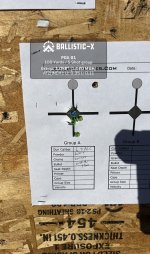 image_cropper_2DAD2F75-5FBB-4F0D-AFF2-E4D26955BACA-1696-0000011B23116A18.JPG704.8 KB · Views: 39
image_cropper_2DAD2F75-5FBB-4F0D-AFF2-E4D26955BACA-1696-0000011B23116A18.JPG704.8 KB · Views: 39 -
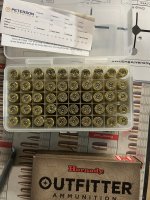 IMG_8968.JPG622.6 KB · Views: 42
IMG_8968.JPG622.6 KB · Views: 42 -
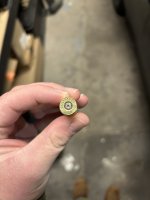 IMG_8967.JPG249.9 KB · Views: 44
IMG_8967.JPG249.9 KB · Views: 44 -
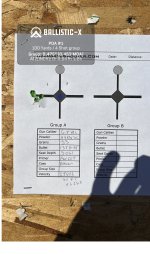 image_cropper_E69397EB-9169-470F-B197-1C3EA12EB1FF-1763-0000011F73E88218.JPG644.3 KB · Views: 39
image_cropper_E69397EB-9169-470F-B197-1C3EA12EB1FF-1763-0000011F73E88218.JPG644.3 KB · Views: 39 -
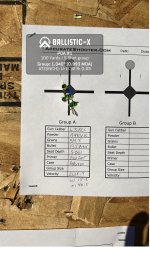 image_cropper_B5294CAA-485E-451B-971F-D1437BF5A401-1877-0000012C2BF380A3.JPG711.7 KB · Views: 41
image_cropper_B5294CAA-485E-451B-971F-D1437BF5A401-1877-0000012C2BF380A3.JPG711.7 KB · Views: 41 -
 image_cropper_AA35952D-7F59-4EA8-BDC8-8BBE3A884048-1948-00000133C3648EBF.JPG666.2 KB · Views: 36
image_cropper_AA35952D-7F59-4EA8-BDC8-8BBE3A884048-1948-00000133C3648EBF.JPG666.2 KB · Views: 36 -
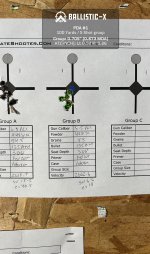 image_cropper_A23F5E40-7E10-4A35-BB83-A199491ADBC4-1924-0000012F60F3FF40.JPG684.4 KB · Views: 39
image_cropper_A23F5E40-7E10-4A35-BB83-A199491ADBC4-1924-0000012F60F3FF40.JPG684.4 KB · Views: 39 -
 image_cropper_9E10F803-5C03-4CF7-932E-28991446F266-1792-0000012372A7C6EA.JPG668.6 KB · Views: 36
image_cropper_9E10F803-5C03-4CF7-932E-28991446F266-1792-0000012372A7C6EA.JPG668.6 KB · Views: 36 -
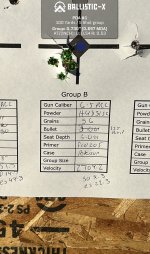 image_cropper_6F059C5B-354C-4870-9251-8C28A4FCC270-1989-000001366DCE33B0.JPG629.6 KB · Views: 42
image_cropper_6F059C5B-354C-4870-9251-8C28A4FCC270-1989-000001366DCE33B0.JPG629.6 KB · Views: 42 -
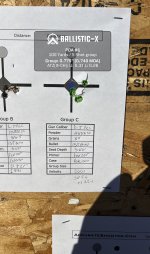 image_cropper_3A9297DC-CBBB-4A7C-B391-FFD058A4479D-1808-000001267A9C9427.JPG610.4 KB · Views: 51
image_cropper_3A9297DC-CBBB-4A7C-B391-FFD058A4479D-1808-000001267A9C9427.JPG610.4 KB · Views: 51
Last edited:
That velocity for H4831sc is about right if you're shooting in pretty cool weather . . . like 40°F or colder.I went out today to start load development. For reference, this is a tikka veil that was cut and threaded at 18" by class 3 machine. It has a total of about 60 rounds through it (I may be wasting my time starting any of this before giving the barrel a chance to speed up, which i certainly hope it does). Temperature today was about 50 degrees. Hornady lists 51.1-56.6 for H4831SC. I loaded (5 shots of each) 53-56 in .5 grain increments. I do not show any pressure signs on the brass and will continue to go up. Velocities were much lower than I had hoped with the 135s so far.
This was all done with new peterson brass.
53 grains was 2564 average, 53.5 was 2581.5, 54 was 2601.3, 54.5 was 2618.9, 55 was 2662.6, 55.5 was 2685.6 and 56 was 2704.2. I found it a little strange that i only averaged about 18 fps gain for 0.5 grain increment bumps (aside from the 43.7 jump from 54.5 to 55). Everything shot relatively well, most around .5-.75 and SD/ES was relatively good. These are all seated 25 thousands off the lands.
As stated I will continue to work up, but based on the velocities shown so far (unless the barrel speeds significantly in the next 100-150 rounds) I may pressure out before breaking 2800-2850.
Factory Hornady outfitter 130 grain was 2751.7 and grouped okay, quite well if I don't account for the flyer on the bottom. The shot above the group was my initial sighter.
I do have some H1000 that may be worth trying as well.
Also, ignore the "federal 205" on the primer, these were federal 210s, i just miswrote on every target.
H1000 isn't going to do as well and get you to your expectations with that 18" barrel.
I'm still hopefull to push a 130 closer to 2850. I was hitting 2700 with a 140 ELDM in a 20" creedmoor, so I will be a bit bummed if the short PRC can't exceed that by a decent amount. Several folks are saying they are pushing 2900+ with 130s-135s with H4831sc in an 18-19" prc, so I am hoping my barrel just needs to speed a bit. I'm not going to be too upset if i can't get there, i knew it was a bit of a gamble going short with the PRC.That velocity for H4831sc is about right if you're shooting in pretty cool weather . . . like 40°F or colder.
H1000 isn't going to do as well and get you to your expectations with that 18" barrel.
Yeah, it takes about 150+ for the barrel to speed up, which is about where my 6.5 PRC barrel did.I'm still hopefull to push a 130 closer to 2850. I was hitting 2700 with a 140 ELDM in a 20" creedmoor, so I will be a bit bummed if the short PRC can't exceed that by a decent amount. Several folks are saying they are pushing 2900+ with 130s-135s with H4831sc in an 18-19" prc, so I am hoping my barrel just needs to speed a bit. I'm not going to be too upset if i can't get there, i knew it was a bit of a gamble going short with the PRC.
Sadly it seems rl26 has been discontinuedNot what your looking for specifically but 2800 avg fps with 55.3 gr RL26 and 156 Bergers. 18" Proof Carbon barrel. 54.9 was the most accurate followed by the 55.3. 55.3 had best ES/SD for me in low single digits. Both shot in the .3-.4s Mag length at 2.970. Sammi chamber. Tried othe powders and lighter bullets but nothing was better then the combo above.
Yeah. Tikka barrels are relatively known for being slower, hopefully this isn’t going to be the case. Eventually it will probably get an ace prefit from UM. I have some 140 ELDMs I don’t plan to shoot as this is primarily going to be a hunting rifle. I might just throw a moderate load with them to get some rounds down the barrel so I don’t have to do it with the pricy A tipsYeah, it takes about 150+ for the barrel to speed up, which is about where my 6.5 PRC barrel did.
I am at 56 gr of H4831sc for the 130’s in the 18” barrel.Can I ask what charge you’re using in the 18 to hit that 2900? So far I’ve worked to 56 grains, and barely broken 2700 with the 135
56.5 for the 140’s in the 20” barrel.
Went back out today (30 degrees and 20 mph wind).
56.5 grains was 2760 (5.2 sd 15.7 ES), 57 grains was 2782.1 (18.9 SD 53.1 es) 57.3 was 2782.5 13.4 SD 34.4 spread, 57.6 was 2806.7 (7.8 SD 19.2 spread) All 5 shot strings. 57.6 had some heavy bolt lift on 2 rounds and some ejector mark on 1-2 cases. I did have a small ejector mark on one piece each of 57 and 57.3. I may load a few more up and see if they show any other signs of pressure. I am likely going to sell the A tips/trade them for some 129 ABLRs, 130 accubonds, 130 sierra game changers, 135 berger classic hunters or something else similarly aligned to a decent BC hunting bullet. I'll probably load up some 140 ELDMs at a mild load to get some rounds on the barrel to see if it speeds up as well. There is a cold front moving in the next week, so I likely won't make it back out for a while.
56.5 grains was 2760 (5.2 sd 15.7 ES), 57 grains was 2782.1 (18.9 SD 53.1 es) 57.3 was 2782.5 13.4 SD 34.4 spread, 57.6 was 2806.7 (7.8 SD 19.2 spread) All 5 shot strings. 57.6 had some heavy bolt lift on 2 rounds and some ejector mark on 1-2 cases. I did have a small ejector mark on one piece each of 57 and 57.3. I may load a few more up and see if they show any other signs of pressure. I am likely going to sell the A tips/trade them for some 129 ABLRs, 130 accubonds, 130 sierra game changers, 135 berger classic hunters or something else similarly aligned to a decent BC hunting bullet. I'll probably load up some 140 ELDMs at a mild load to get some rounds on the barrel to see if it speeds up as well. There is a cold front moving in the next week, so I likely won't make it back out for a while.
It sounds like your barrel is just really slow. If you do end up replacing it, I would call carbon six and order a prefit. They are awesome barrels.Went back out today (30 degrees and 20 mph wind).
56.5 grains was 2760 (5.2 sd 15.7 ES), 57 grains was 2782.1 (18.9 SD 53.1 es) 57.3 was 2782.5 13.4 SD 34.4 spread, 57.6 was 2806.7 (7.8 SD 19.2 spread) All 5 shot strings. 57.6 had some heavy bolt lift on 2 rounds and some ejector mark on 1-2 cases. I did have a small ejector mark on one piece each of 57 and 57.3. I may load a few more up and see if they show any other signs of pressure. I am likely going to sell the A tips/trade them for some 129 ABLRs, 130 accubonds, 130 sierra game changers, 135 berger classic hunters or something else similarly aligned to a decent BC hunting bullet. I'll probably load up some 140 ELDMs at a mild load to get some rounds on the barrel to see if it speeds up as well. There is a cold front moving in the next week, so I likely won't make it back out for a while.
That’s the plan eventually. This is primarily going to be a sub 500 hunting rifle, so as long as I can run 130s at 2800+ I’ll be satisfiedIt sounds like your barrel is just really slow. If you do end up replacing it, I would call carbon six and order a prefit. They are awesome barrels.
Also, I'm sure I missed it somewhere, but make sure you are using magnum primers.That’s the plan eventually. This is primarily going to be a sub 500 hunting rifle, so as long as I can run 130s at 2800+ I’ll be satisfied
All of these were done with non magnum federal. I haven’t been able to find magnums locally for a while, I’ll have to do some looking
That could be a small part of your problem.All of these were done with non magnum federal. I haven’t been able to find magnums locally for a while, I’ll have to do some looking
The throat on my and my buddy’s Tikka are long. If your mag allows stretch that reload out and add slower powder, or go more powder at the normal length. Weatherby rifles used a lot of freebore to get velocity without ramping up the pressure real fast. Find what your base to ogive distance is at the lands and shorten your reloads by 20+ thou or so. Work up slow.Yeah. Tikka barrels are relatively known for being slower, hopefully this isn’t going to be the case. Eventually it will probably get an ace prefit from UM. I have some 140 ELDMs I don’t plan to shoot as this is primarily going to be a hunting rifle. I might just throw a moderate load with them to get some rounds down the barrel so I don’t have to do it with the pricy A tips
Currently seated at about 3.060 which is the longest my mag will allow. 3.086 is my coal touching the lands with the 135. I did pick up some magnum primers today, and ordered some 129 ablrs. Going to give it a go with h1000 when it’s above -4 again.The throat on my and my buddy’s Tikka are long. If your mag allows stretch that reload out and add slower powder, or go more powder at the normal length. Weatherby rifles used a lot of freebore to get velocity without ramping up the pressure real fast. Find what your base to ogive distance is at the lands and shorten your reloads by 20+ thou or so. Work up slow.
Did you have any gains with the magnum primers?Currently seated at about 3.060 which is the longest my mag will allow. 3.086 is my coal touching the lands with the 135. I did pick up some magnum primers today, and ordered some 129 ablrs. Going to give it a go with h1000 when it’s above -4 again.
I actually ended up moving away from the A tip as I was not going to hunt with them. I gave a small go with 129 ABLR's and got them to 2866 with H1000, but never had a group under 2". I am currently trying Berger 140 EH. Using N565 I am right around 2700 at the moment with groups from 0.3-0.5 moa, however my ES and SD is higher than I would like (avg SD is 20). I am going to try and fine tune that a little, but I will also try H1000 and H4831SC with these.Did you have any gains with the magnum primers?
Curious how your project is progressing, since we have similar interests.Currently seated at about 3.060 which is the longest my mag will allow. 3.086 is my coal touching the lands with the 135. I did pick up some magnum primers today, and ordered some 129 ablrs. Going to give it a go with h1000 when it’s above -4 again.
Although I lean towards higher BC (heavier) bullets such as the 147 ELDM, with an 18" to 20" suppressed barrel.
My very personal reaction (not to criticize your choice) is that if a shooter is choosing a 6.5 PRC and "chasing velocity" (don't we all), and doing so with light lower BC bullets, then that implies that the shooter is either using the rifle in calm conditions or not expecting a 400+ yard shot where wind drift is the biggest concern, or the shooter is an expert wind caller. If the rifle is destined to be used inside of 300 yards with light bullets, then isn't velocity a lot less important (because there is plenty of terminal velocity for that distance)? (again, I'm like everyone else and want as much velocity as I can get provided the rifle is accurate...).
I've been largely away from my rifle while focusing on archery for close to 15 years, but am now pivoting back to the rifle. FWIW, when I was precision reloading actively back then, the benchrest experts liked to seat bullets close(r) to the lands.
You mentioned you are almost touching the lands.
I have learned that the world of hunting / shooting rifles has changed dramatically over the last 15 years. It seems that recent guidance is that if you are touching or "almost touching" the lands then the risks of greater pressure and POI impact increase dramatically (perhaps explaining your picture showing a primer with cratering, and others without cratering). A bullet that has some jump has lower pressure and performs differently than a bullet with jam. Given variances in loads (actual length to ogive) , cartridges loaded to touch, or nearly touch, the lands are more likely to have more erratic performance. The current thinking seems to be to increase bullet jump to avoid that region of higher pressure and POI variability.
I've heard some folks now recommend jumping around 65 thousandths if the rifle / cartridge is used for competition that involves high volume shooting without cleaning. This is apparently because a hot cartridge like 6.5 PRC will erode the bore and build up carbon relatively quickly, thus changing the ballistic characteristics and point of impact. X thousands of barrel erosion might be a big deal if the bullet was initially touching the lands, but it becomes a smaller and smaller deal as the jump increases out to about 65 thousandths. That concept makes intuitive sense to me, although intuition may not have a place in relation to the rocket science of internal ballistics. Bottom line, it has been suggested that pressure variability and POI changes are minimized with more jump (within a reasonable range). This is not to say that 65 thousands jump is ideal for a benchrest gun that is cleaned more frequently and where the shooter can increase COAL during a match if necessary, or that it is the right jump for YOUR rifle and load combination. But it is something to think about, especially in relation to one or two of your cartridges showing early pressure signs.
Hope the helps or maybe just raises more questions. Again, I'm following because I have similar interest to yours and I appreciate your question and responses.
Bullet jump is pretty subjective to the bullet being used. Most people recommend jumping hornady bullets when initially starting load dev about 20 thousandths. This is typically where i start. The 135 A tip is .637 BC, which is barely behind the 140 ELDM. I may end up getting some 147s later on to try. I have taken this load to 1k. I shoot primarily in Nebrask and Wyoming, so i am also no stranger to wind. I am currently shooting 140 Berger EH at about 2700 as well. I have not had my hands on my rifle in about 50 days due to work however, so this project is on hold.
Ive been thinking about a short (16-18") 6.5 PRC for my next elk rifle (because I need one like a hole in the head) but reading this thread has me wondering why I would. Doesn't sound like it does a whole lot over my .260 rem and nothing over the old lady's 18" 270 win except a shorter action (not with a tikka) and a little better BC bullet choice. Tell me why Im wrong and I should get one, +/-100 FPS isn't that convincing. Maybe the PRC isn't a great choice for shorter barrels?
From everything I have read, I have a pretty damn slow barrel. There are guys getting 2850 with 140s, especially if you have RL26 avaliable to you. This is a factory cut down tikka barrel, and they are known for being slow.Ive been thinking about a short (16-18") 6.5 PRC for my next elk rifle (because I need one like a hole in the head) but reading this thread has me wondering why I would. Doesn't sound like it does a whole lot over my .260 rem and nothing over the old lady's 18" 270 win except a shorter action (not with a tikka) and a little better BC bullet choice. Tell me why Im wrong and I should get one, +/-100 FPS isn't that convincing. Maybe the PRC isn't a great choice for shorter barrels?
It does sound that way. I cut down the old lady's tikka 270 to 18" so it wasn't quite so unwieldy with a can on it. It shoots 130 ttsx at 2950 with 53.2 of 4350. RL 26 seems to be unobtanium so there's that. I really wanted to not be bratty about another hornady cartridge, but I guess I am. Hopefully your barrel speeds up a bit for you.From everything I have read, I have a pretty damn slow barrel. There are guys getting 2850 with 140s, especially if you have RL26 avaliable to you. This is a factory cut down tikka barrel, and they are known for being slow.
At the end of the day, unless you're trying to kill big critters way out there, it should be plenty of speed. My 260 has killed every elk Ive shot with it just fine and you have about another 100 fps. In my experience bullet choice matters a lot more than cartridge. I'll stop shitting up your thread now since Im sounding fuddy.
Similar threads
- Replies
- 9
- Views
- 412
- Replies
- 19
- Views
- 1K
